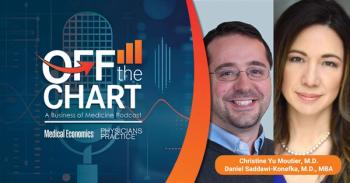
The evolving role of APPs in post-COVID healthcare
One possible remedy for the current state of healthcare is greater use of physician assistants (PAs) and nurse practitioners (NPs) to meet the demands of patient care.
Prior to the COVID-19 pandemic in 2020, the U.S healthcare system was already preparing to face a shortage of primary care providers. According to the Association of American Medical Colleges, the
How the pandemic will affect this shortage is yet to be determined. There is evidence that physician burnout, which was a rising problem pre-pandemic, has been exacerbated by COVID-19. According to a
One possible remedy for the current state of healthcare is greater use of physician assistants (PAs) and nurse practitioners (NPs) to meet the demands of patient care. While using advanced practice providers (APPs)—such as PAs and NPs—to provide patient care has long been customary, the surge of patients during the pandemic has allowed for APPs to practice to the top of their license and make an impact on population health.
Adapting Educational Programs
Educating healthcare professionals during a pandemic created an unprecedented set of challenges in healthcare education. As health networks and teaching hospitals, faced the beginning of COVID-19, multiple issues prompted a cease in student clinical rotations. Procurement of PPE, design of student policies and protocols, and safety concerns are just a few issues that rightfully disrupted healthcare student experiences. For healthcare educators, this rapid change required programs to pivot and creatively determine how to provide required educational components, training experiences adequate to meet learning outcomes, and continued standards of educational competency.
Navigating through the pandemic has allowed program faculty and leadership to incorporate innovative curricular components to enable students to continue to progress through their education while appropriately managing the challenges of the pandemic. Currently, didactic adjustments due to online learning requirements, preceptor burnout, office space limitations due to social distancing, and increased competition for clinical placement sites from programs that are working to graduate their students all still create challenges for healthcare faculty. Throughout these challenges, many faculty continued to instill a sense of calm in their students, addressing fears and concerns, and managing expectations of inexperienced healthcare providers.
Incorporating Virtual and Simulation Tools
Increased use of virtual and simulation experiences is one strategy for healthcare educators to continue providing educational content. Long used to augment teaching, simulation is integral to training. The pandemic has encouraged educators to use virtual patient experience software and design and incorporate content-rich simulation cases to enhance student learning. However, many of these resources are costly, and budget limitations of some higher education facilities may limit available options.
Looking for educational resources led many of my fellow educators to discover a resource for free information that I use called POCN. It offers PAs and NPs an opportunity to learn with free resources for continuing medical education (CME). Many of these CME offerings help educators maintain our command of current medical literature and advancements in disease management and treatment. While these offerings are useful to educators by providing evidence-based information to allow faculty to teach to current standards of care, they also help when CME reimbursements from employers may be negatively affected. As providers, we must meet our organizational requirements for continuing education, and if funding for these activities is limited due to financial constraints, POCN offers accessible multimedia resources.
In addition to web-based articles, there are video streaming resources accessible via web-based applications or smartphone apps that provide case studies and expert presentations to enhance patient care through POCN+. With a busy schedule, this has helped me learn when I have spare time. I’ve found the patient case studies helpful for any APP preparing for recertification. In these case studies, the results of an extensive patient workup are reviewed and followed by the actual diagnosis and treatment.
Broadening Roles and Recognizing Benefits
As we continue to prepare for the post-pandemic future of healthcare, we must continue to allow APPs to maximize their skills and experience in expanded roles. Leadership within our healthcare systems can benefit from the expertise of PAs and NPs. For example, many hold additional advanced degrees in business or education. Responsibilities and leadership opportunities are shifting to incorporate more APPs in middle and upper-level management. Allowing APPs a voice in health network policies and procedures can lead to better .e of these individuals throughout the healthcare system, improving patient outcomes and resource utilization.
The U.S. healthcare system is navigating the one of the most challenging landscapes in generations, but these challenges have also led to many positive changes. First, COVID-19 constraints prompted providers to expand patient care through telemedicine. The technology that allows patients to access quality, convenient care from the safety of their home should remain post-pandemic. Second, the challenges have inspired a camaraderie that is much needed in medicine. A key to traversing the challenges we are all facing is relying on our colleagues to offload burdens whether intellectual, physical, or emotional.
Our sense of moral obligation and our belief in making a positive impact can be passed on to the next generation of medical providers. These students and newly graduated providers possess a resilience that the COVID-19 pandemic has intensified. They faced adversity and uncertainty that forced them to adapt quickly and adjust to a rapidly changing healthcare system. These students entered their new careers amidst the reality of a crashing job market, the ambiguity of a novel virus, and an already stressed healthcare system. Further research will allow us to determine how this generation of healthcare providers’ resilience and motivation will impact patient outcomes.
There is no doubt that the COVID-19 pandemic has made indelible changes in our healthcare system. As we continue to manage the new normal of our roles as providers, we must continue to find ways to support each other and our healthcare colleagues, including educating our students, providing accessible resources, and optimizing APCs’ skills in expanded roles in our networks.
About the Author
Barbara Morici, MSPAS, PA-C, DFAAPA is the director of Clinical Education and an assistant professor at the DeSales University Physician Assistant Program.
Newsletter
Optimize your practice with the Physicians Practice newsletter, offering management pearls, leadership tips, and business strategies tailored for practice administrators and physicians of any specialty.









